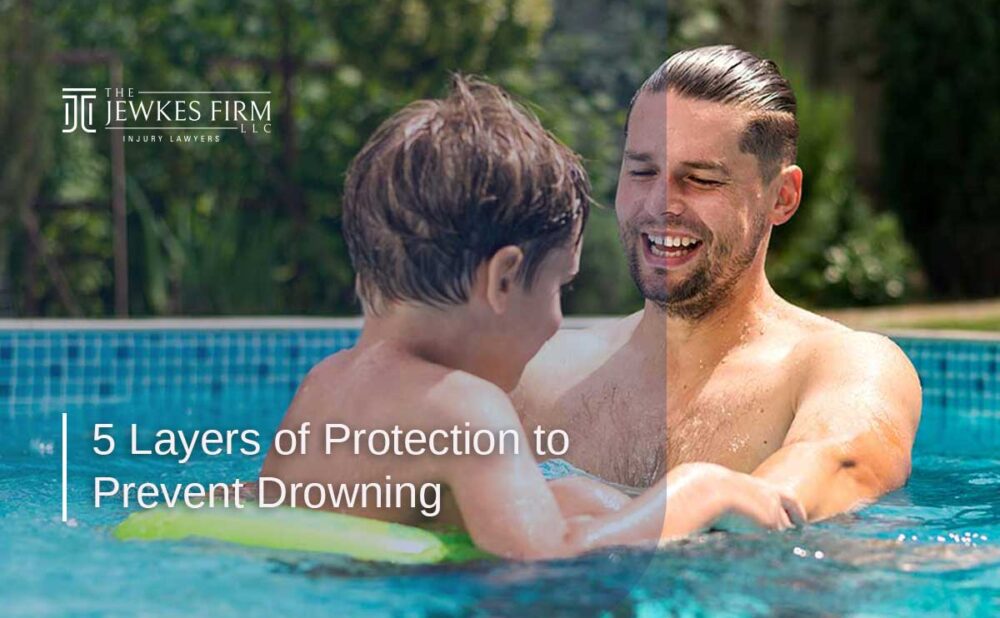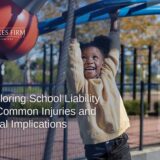5 Layers of Protection to Prevent Drowning
Drowning is a silent and often overlooked tragedy that can affect anyone, regardless of age or swimming ability. According to the Centers for Disease Control and Prevention (CDC), drowning is a leading cause of unintentional injury death for children aged 1 to 4 years. As personal injury attorneys at The Jewkes Firm, we understand the importance of prevention and safety measures to protect our community. The National Drowning Prevention Alliance (NDPA) has developed a comprehensive framework known as the “5 Layers of Protection” to help reduce the risk of drowning. In this article, we will explore these layers and how we can use them to make a safer place for everyone.
1. Barriers and Alarms
The first layer of protection involves physical barriers that can prevent unsupervised access to water. These barriers are essential for keeping children safe, especially in residential settings. Consider the following:
Effective pool fencing and safety devices create a robust first line of defense. The first layer of protection involves physical barriers that can prevent unsupervised access to water. These barriers are essential for keeping children safe, especially in residential settings. Key elements include:
- Pool Fencing. Install a four-sided fence that is at least four feet high around the pool area, with self-closing and self-latching gates.
- Safety Covers. Always use safety covers that follow industry standards. Maintain regularly for pools and spas when they are not in use to prevent accidental entry.
- Alarms. Install door and pool alarms that alert you when someone enters the pool area unexpectedly.
Why it matters — More than 70% of child drownings happen during non‑swim times—when kids wander into the water without anyone noticing .
2. Supervision
Even with barriers in place, constant, capable, and undistracted adult supervision is essential. The most critical layer of protection is supervision. Active supervision means having a responsible adult present and attentive when children are near water. This covers pools, lakes, rivers, and even bathtubs. Here are several important points to keep in mind:
- Designate a Water Watcher. Assign a specific adult to watch over the children in the water. Ensuring the “supervisor” is focused and not distracted by phones or conversations. Train caregivers, babysitters, and others in vigilant scanning and head‑count routines.
- Use the “10/20 Rule.” This rule suggests that a supervisor should be able to see the child in the water within 10 seconds and reach them within 20 seconds if necessary. Maintain “touch supervision,” keeping even young children within arm’s reach.
- Avoid Alcohol. Alcohol consumption can impair judgment and reaction times, making it crucial to remain sober while supervising children in or near water.
Supervision is the ever-present safeguard — it’s the layer we should never ignore.
3. Water Competency
Teaching swimming skills is an essential layer of protection that empowers individuals to be safer in and around water. Equipping everyone—adults and children—with fundamental water skills helps prevent drownings. Here are some recommendations:
- Enroll in Swim Lessons. Encourage children and adults to take swim lessons from certified instructors. Enroll children as early as age 1 in swim lessons that build confidence and survival skills, such as floating, treading, and safe pool exits.
- Continuous Learning. Practice swimming skills regularly, as proficiency can diminish over time.
- Water Safety Education. Teach children about water safety, including recognizing dangerous situations and how to respond if they find themselves in trouble.
Swim lessons reduce drowning risk by up to 88% when combined with other protections.
4. Life Jackets
Life jackets are a vital layer of protection, especially for children and inexperienced swimmers. Approved life jackets are indispensable—especially in open water or when children are unfamiliar with their surroundings. Life jackets offer buoyancy and can save lives in emergencies. Here’s how to effectively use life jackets:
- Proper Fit. Ensure that life jackets are U.S. Coast Guard-approved and fit snugly on the wearer. They should not be too loose or too tight.
- Mandatory Use. Require children to wear life jackets when boating, swimming in open water, or participating in water sports, even if they are good swimmers.
- Educate on Usage. Teach children the importance of wearing life jackets and how to use them correctly.
Remember — life jackets don’t replace supervision or swim lessons—they add a crucial safety net.
5. Emergency Preparedness
The final layer of protection is emergeny preparedness. Knowing how to respond in a drowning situation can make a significant difference. Even with multiple layers in place, drowning emergencies can still happen. Being prepared is vital:
- Learn CPR. Sign up for CPR and first aid courses so you can be ready for emergencies. Knowing how to perform CPR can save a life while waiting for professional help.
- Have Rescue Equipment Accessible. Keep rescue equipment, such as life rings, reaching poles, and a first aid kit, readily available near pools and other water bodies.
- Emergency Contacts. Have a list of emergency contacts, including local emergency services, posted in visible areas near water. In an emergency, call 911 immediately, then begin CPR with rescue breaths.
Each layer serves a distinct purpose—some block access, some delay access, and others minimize harm or facilitate rescue. When combined, they form a robust shield of protection.
Impacted by a Drowning Injury or Loss? Contact Us For A Free Consultation
Impacted by a Drowning Injury or Loss?
How The Jewkes Firm Champions Water Safety
At The Jewkes Firm, led by Attorney Jordan Jewkes, we understand the profound impact that accidental injuries and preventable tragedies have on families. With decades of advocacy and litigation experience, our mission extends beyond legal recovery—we promote safety, prevention, and accountability.
If your loved one has been affected by a drowning or near‑drowning incident—whether at home, in a community facility, or on premises owned by others—we’re here to help. We investigate lapses in:
- Fence or alarm system maintenance
- Supervision policies (life guards, caregiver protocols)
- Qualified swim instruction provision
- Availability of safety equipment and emergency planning
We combine legal expertise with genuine compassion to pursue justice and safety for families in crisis.
Water Safety is a Shared Responsibility
Drowning is a preventable tragedy, and the 5 Layers of Protection outlined by the National Drowning Prevention Alliance provide a comprehensive approach to safeguarding individuals, especially children, from drowning incidents. At The Jewkes Firm, we believe that awareness and education are key components in preventing personal injuries related to water activities. By implementing these layers of protection, we can create a safer environment for our families and communities.
If you or a loved one has been affected by a drowning incident or any other personal injury, we are here to help. Contact The Jewkes Law Firm at (770) 771-5130 for a free consultation.

GEORGIA PERSONAL INJURY LAWYER NEAR ME
Frequently Asked Questions
Why is supervision not enough to prevent drowning?
While supervision is essential, it’s not foolproof. Children can wander into pools during “non-swim” times. That’s why the NDPA recommends multiple layers—especially alarms and barriers—as backup defenses.
What age should my child start swimming lessons?
The American Academy of Pediatrics supports starting swimming lessons as early as age 1, depending on a child’s development and comfort level in water.
Can I file a lawsuit for a drowning or near-drowning?
Yes. If the incident was caused by unsafe conditions, negligent supervision, or a failure to follow safety protocols, you may receive compensation. An experienced personal injury attorney like Jordan Jewkes can evaluate your case.
How can barriers help prevent drowning?
Physical barriers, such as pool fences and safety covers, restrict unsupervised access to water, significantly reducing the risk of accidental drownings.
When should children wear life jackets?
Children should wear life jackets whenever they are in or around water, especially when boating or participating in water sports, regardless of their swimming ability.
What should I do in a drowning emergency?
If someone is drowning, call emergency services immediately, perform CPR if trained, and use rescue equipment if available. Being prepared can save lives.




